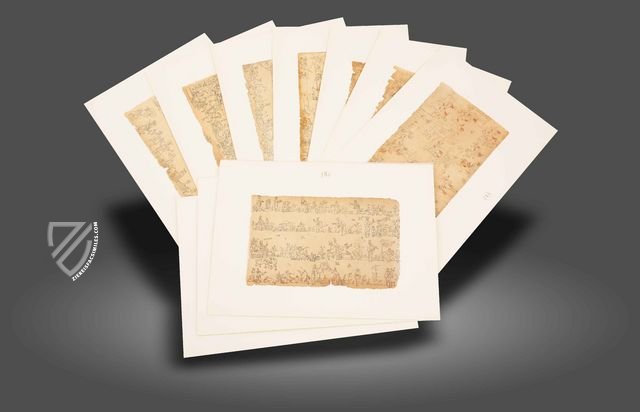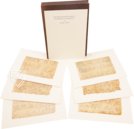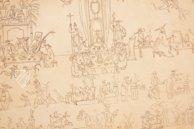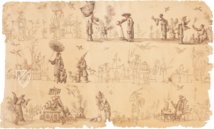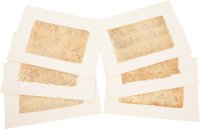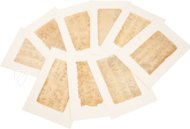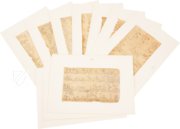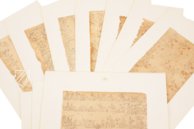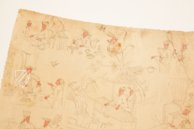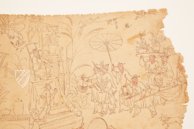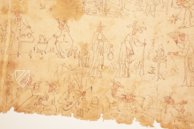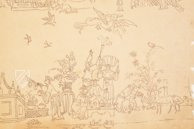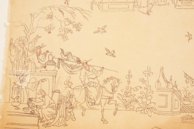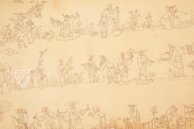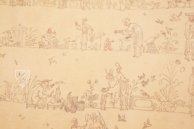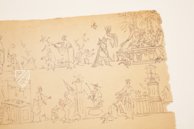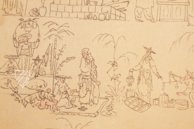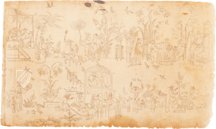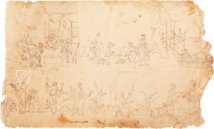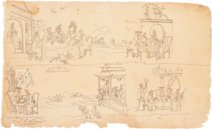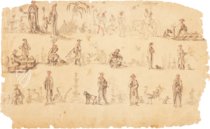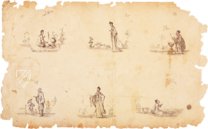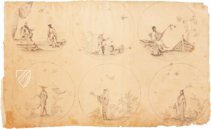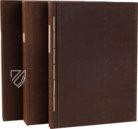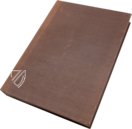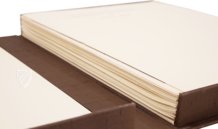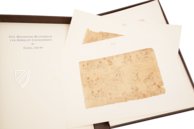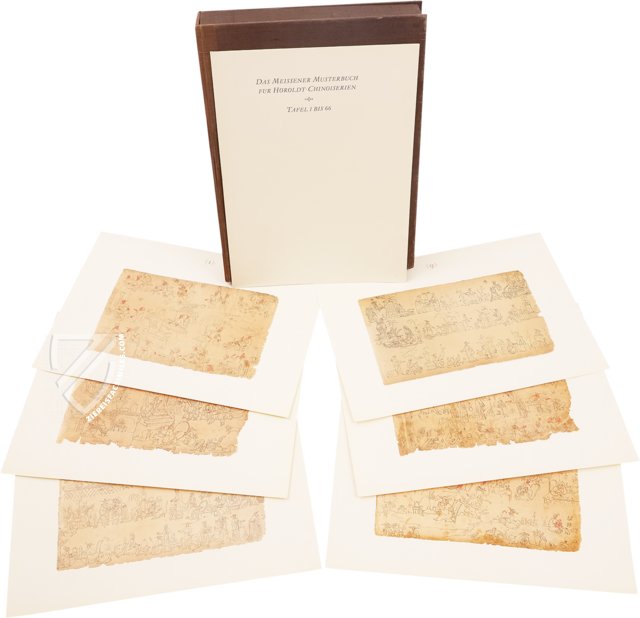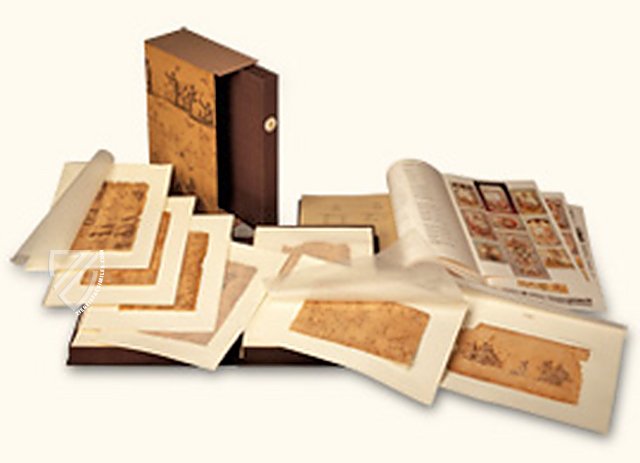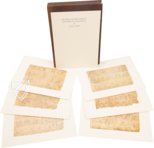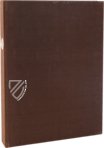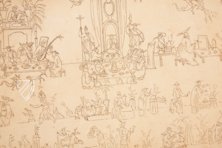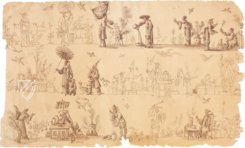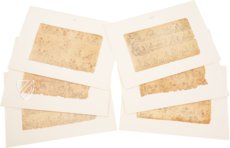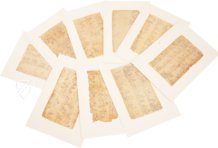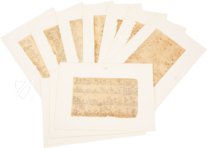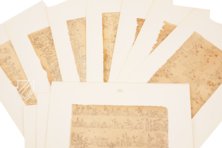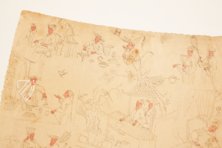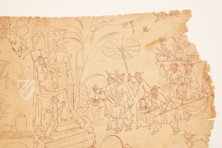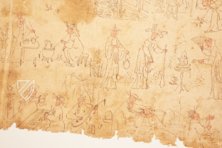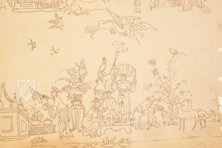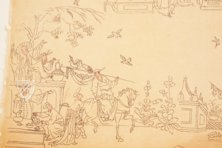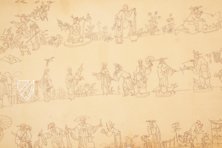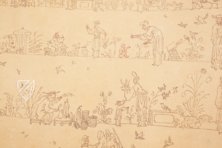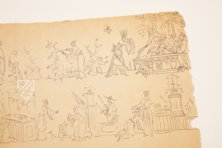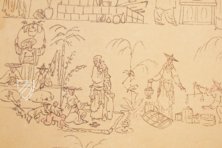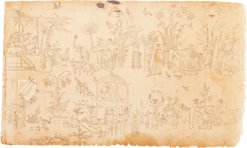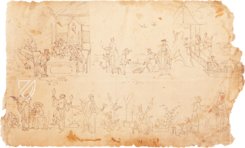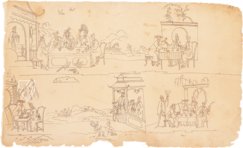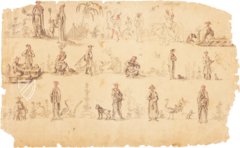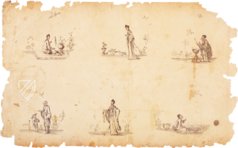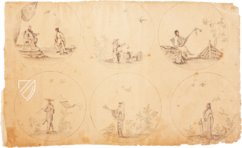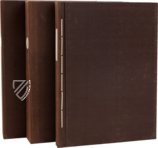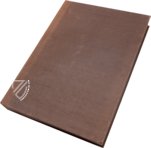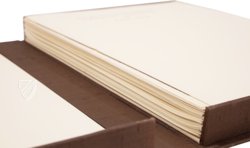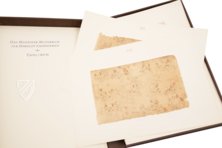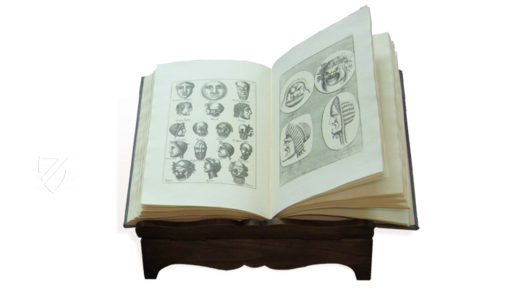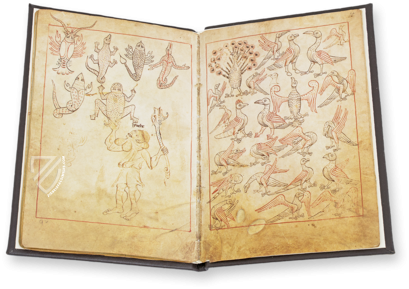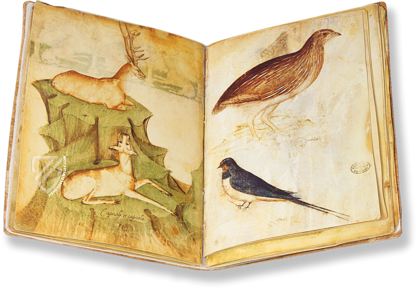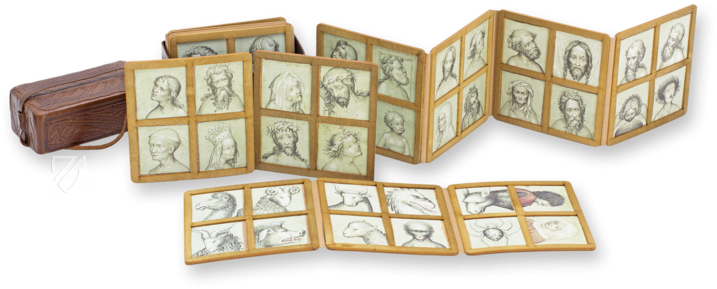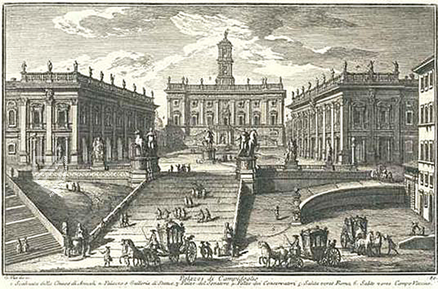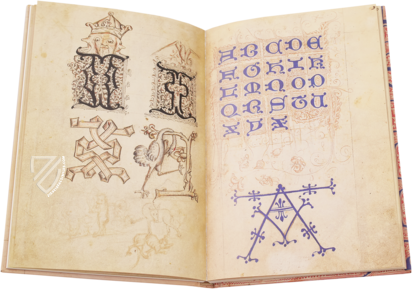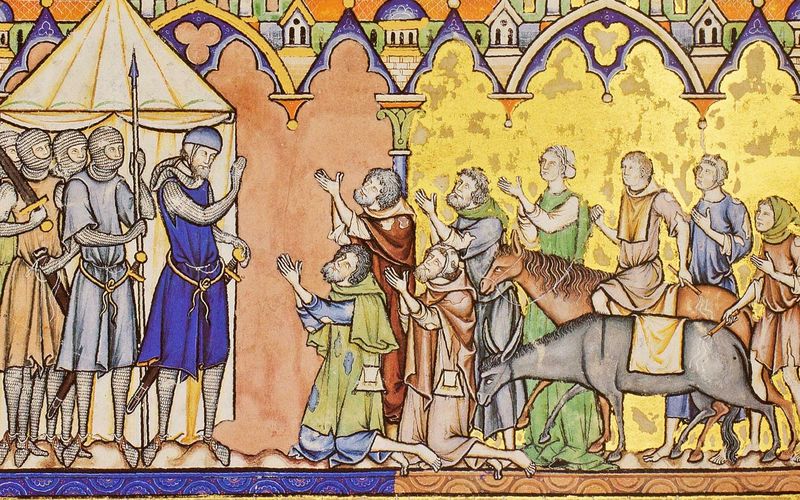Meissen Models for the Höroldt Chinoiseries
(1,000€ - 3,000€)
A unique treasure chest of European porcelain painting: the so-called I modelli di Meissen per le cineserie Höroldt. Johann Gregorius Höroldt, active in Meissen beginning in 1720, is generally considered to be the most famous porcelain painter. He was a court painter in Meissen, which was the center of European porcelain manufacturing, and is particularly renowned for his “Chinoseries” – porcelain decorated in the Chinese style. The splendid motifs include plants, birds, and other animals, humans in exotic garments, and much more. It is no surprise that Höroldt is considered to be the “progenitor of the European style of porcelain.” This great art is brought back to life in the 1,000+ designs from his hand and from the hands of his students!
Meissen Models for the Höroldt Chinoiseries
The foundation of the first German porcelain factory in Meissen in the year 1710 sealed a success story that continues to this day. After the secret of white gold from China was discovered, one could now produce porcelain. With gorgeous, colorful décor for each fashion, Meissen porcelain has become a byword for quality and luxury.
The Greatest Porcelain Painter
One of the most significant personalities of this success story was the porcelain painter Johann Gregorius Höroldt (1696–1775). Höroldt, who was from Jena, was active in Vienna and was a court painter in Meissen from 1720 onward, and is considered to be the “progenitor of the European style of porcelain.” Höroldt rose to be head of porcelain painting in Meissen. Additionally, he developed other techniques for new glaze colors. As such, the famous porcelain painted was famous across Europe. Höroldt’s "Chinoiseries" – porcelain decorated in the Chinese style – made him famous in particular!
Chinese Scenes…
The wonderfully light scenes in the contemporary style of the Chinoiseries are an expression of their time: Chinese motifs such as plants, birds, and other animals, humans in exotic garments, and much more in the Chinese fashion in art and architecture was particularly popular in the 18th century. These designs by Höroldt, who decorated the famous porcelain of Meissen – cups, vases, tea caddies, and more – some of which are still produced today!
A Priceless Compendium
These authoritative designs were recorded in the I modelli di Meissen per le cineserie Höroldt, also known as the Schulz Codex (after Georg Wilhelm Schulz, a businessman from Leipzig, who probably acquired the drawings circa 1900). 132 pages with more than 1,000 sketches from various hands – alongside Höroldt’s own designs, one finds exercises and submissions from his apprentices – make the I modelli di Meissen per le cineserie Höroldt a true treasure chest of chinoiserie décor. The students of Höroldt who are represented here are among those who measurably shaped the history of porcelain painting in Europe. The I modelli di Meissen per le cineserie Höroldt can thus be regarded as the most significant testimonial to European porcelain painting!"
Codicology
- Alternative Titles
- I modelli di Meissen per le cineserie Höroldt
Schulz Codex
Codice Schulz
Meissener Musterbuch
I modelli di Meissen per le cineserie Höroldt - Type
- Manuscript on paper
- Size / Format
- 3 volumes / Up to 50 × 36 cm
- Origin
- Germany
- Date
- 18th century
- Epochs
- Language
- Illustrations
- Over 1000 drawings and sketches
- Artist / School
- Johann Gregorius Höroldt (1696–1775) and other painters
Meissen Models for the Höroldt Chinoiseries
Model for a Dinner Plate
Presented in a circle approximating the “well” (the bottom where food is placed) of a dinner plate, this sketch depicts a well-dressed, elderly man with a long moustache. He holds a hand fan and extends his right arm to reveal the wide, hanging sleeves of his robe and appears to be waving off a crane or some similar type of bird that is standing in front of him. Lacking a proper background, the outdoor setting of the scene is indicated by the presence of two plants and a small bird flying overhead.
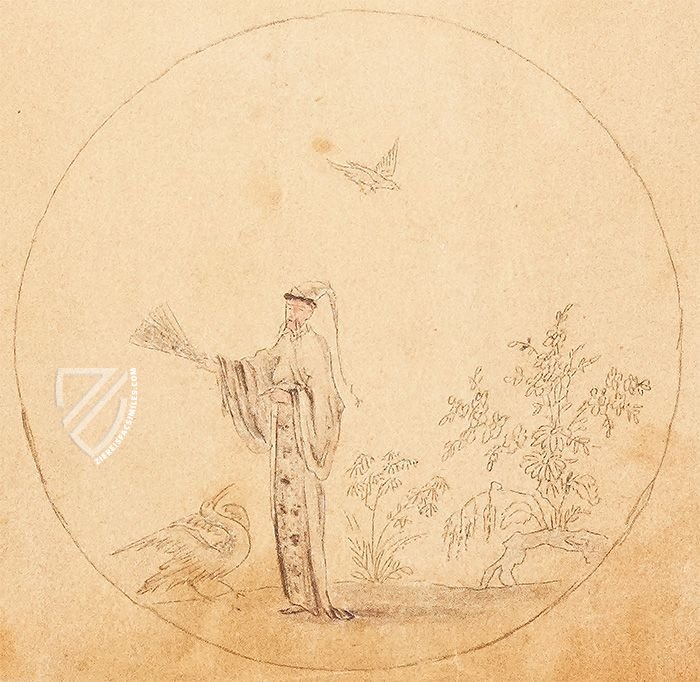
Meissen Models for the Höroldt Chinoiseries
Vignettes in Various Stages of Completion
The figures presented on this page range from sketches with simple outlines to finished, realistic drawings complete with shaded falls of folds and the figures themselves casting shadows. Some of them brew tea over smoking stoves and serve steaming cups to one another while others walk hand-in-hand with children, hold babies, or nod off reclining next to a table.
Many of the elegant human figures make sweeping gestures and all wear hats ranging from simple caps and wide brimmed conical straw hats to pointed cones and feather headdresses. They are accompanied by cats and small dogs scurrying on the ground while birds and even dragons swoop in the air overhead. Numerous everyday objects add to the detail and realism of these vignettes.
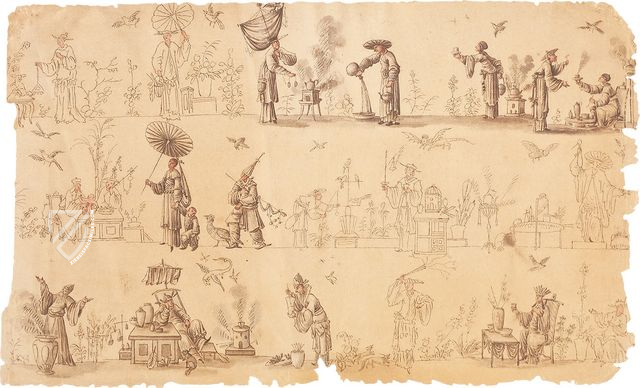
#1 Das Meissener Musterbuch für Höroldt-Chinoiserien
Language: German
(1,000€ - 3,000€)
#2 I modelli di Meissen per le cineserie Höroldt
Language: German
(1,000€ - 3,000€)
- Treatises / Secular Books
- Apocalypses / Beatus
- Astronomy / Astrology
- Bestiaries
- Bibles / Gospels
- Chronicles / History / Law
- Geography / Maps
- Saints' Lives
- Islam / Oriental
- Judaism / Hebrew
- Single Leaf Collections
- Leonardo da Vinci
- Literature / Poetry
- Liturgical Manuscripts
- Medicine / Botany / Alchemy
- Music
- Mythology / Prophecies
- Psalters
- Other Religious Books
- Games / Hunting
- Private Devotion Books
- Other Genres
- Afghanistan
- Armenia
- Austria
- Belgium
- Belize
- Bosnia and Herzegovina
- China
- Colombia
- Costa Rica
- Croatia
- Cyprus
- Czech Republic
- Denmark
- Egypt
- El Salvador
- Ethiopia
- France
- Germany
- Greece
- Guatemala
- Honduras
- Hungary
- India
- Iran
- Iraq
- Israel
- Italy
- Japan
- Jordan
- Kazakhstan
- Kyrgyzstan
- Lebanon
- Liechtenstein
- Luxembourg
- Mexico
- Morocco
- Netherlands
- Palestine
- Panama
- Peru
- Poland
- Portugal
- Romania
- Russia
- Serbia
- Spain
- Sri Lanka
- Sweden
- Switzerland
- Syria
- Tajikistan
- Turkey
- Turkmenistan
- Ukraine
- United Kingdom
- United States
- Uzbekistan
- Vatican City
- A. Oosthoek, van Holkema & Warendorf
- Aboca Museum
- Ajuntament de Valencia
- Akademie Verlag
- Akademische Druck- u. Verlagsanstalt (ADEVA)
- Aldo Ausilio Editore - Bottega d’Erasmo
- Alecto Historical Editions
- Alkuin Verlag
- Almqvist & Wiksell
- Amilcare Pizzi
- Andreas & Andreas Verlagsbuchhandlung
- Archa 90
- Archiv Verlag
- Archivi Edizioni
- Arnold Verlag
- ARS
- Ars Magna
- ArtCodex
- AyN Ediciones
- Azimuth Editions
- Badenia Verlag
- Bärenreiter-Verlag
- Belser Verlag
- Belser Verlag / WK Wertkontor
- Benziger Verlag
- Bernardinum Wydawnictwo
- BiblioGemma
- Biblioteca Apostolica Vaticana (Vaticanstadt, Vaticanstadt)
- Bibliotheca Palatina Faksimile Verlag
- Bibliotheca Rara
- Boydell & Brewer
- Bramante Edizioni
- Bredius Genootschap
- Brepols Publishers
- British Library
- C. Weckesser
- Caixa Catalunya
- Canesi
- CAPSA, Ars Scriptoria
- Caratzas Brothers, Publishers
- Carus Verlag
- Casamassima Libri
- Centrum Cartographie Verlag GmbH
- Chavane Verlag
- Christian Brandstätter Verlag
- Circulo Cientifico
- Club Bibliófilo Versol
- Club du Livre
- CM Editores
- Collegium Graphicum
- Collezione Apocrifa Da Vinci
- Comissão Nacional para as Comemorações dos Descobrimentos Portugueses
- Coron Verlag
- Corvina
- CTHS
- D. S. Brewer
- Damon
- De Agostini/UTET
- De Nederlandsche Boekhandel
- De Schutter
- Deuschle & Stemmle
- Deutscher Verlag für Kunstwissenschaft
- DIAMM
- Droz
- E. Schreiber Graphische Kunstanstalten
- Ediciones Boreal
- Ediciones Grial
- Ediclube
- Edições Inapa
- Edilan
- Editalia
- Edition Deuschle
- Edition Georg Popp
- Edition Leipzig
- Edition Libri Illustri
- Editiones Reales Sitios S. L.
- Éditions de l'Oiseau Lyre
- Editions Medicina Rara
- Editorial Casariego
- Editorial Mintzoa
- Editrice Antenore
- Editrice Velar
- Edizioni Edison
- Egeria, S.L.
- Eikon Editores
- Electa
- Emery Walker Limited
- Enciclopèdia Catalana
- Eos-Verlag
- Ephesus Publishing
- Ernst Battenberg
- Eugrammia Press
- Extraordinary Editions
- Fackelverlag
- Facsimila Art & Edition
- Facsimile Editions Ltd.
- Facsimilia Art & Edition Ebert KG
- Faksimile Verlag
- Feuermann Verlag
- Folger Shakespeare Library
- Franco Cosimo Panini Editore
- Friedrich Wittig Verlag
- Fundación Hullera Vasco-Leonesa
- G. Braziller
- Gabriele Mazzotta Editore
- Gebr. Mann Verlag
- Gesellschaft für graphische Industrie
- Getty Research Institute
- Giovanni Domenico de Rossi
- Giunti Editore
- Graffiti
- Grafica European Center of Fine Arts
- Guido Pressler
- Guillermo Blazquez
- Gustav Kiepenheuer
- H. N. Abrams
- Harrassowitz
- Harvard University Press
- Helikon
- Hendrickson Publishers
- Henning Oppermann
- Herder Verlag
- Hes & De Graaf Publishers
- Hoepli
- Holbein-Verlag
- Houghton Library
- Hugo Schmidt Verlag
- Idion Verlag
- Il Bulino, edizioni d'arte
- ILte
- Imago
- Insel Verlag
- Insel-Verlag Anton Kippenberger
- Instituto de Estudios Altoaragoneses
- Instituto Nacional de Antropología e Historia
- Istituto dell'Enciclopedia Italiana - Treccani
- Istituto Ellenico di Studi Bizantini e Postbizantini
- Istituto Geografico De Agostini
- Istituto Poligrafico e Zecca dello Stato
- Italarte Art Establishments
- Jan Thorbecke Verlag
- Johnson Reprint Corporation
- Josef Stocker
- Josef Stocker-Schmid
- Jugoslavija
- Karl W. Hiersemann
- Kasper Straube
- Kaydeda Ediciones
- Kindler Verlag / Coron Verlag
- Kodansha International Ltd.
- Konrad Kölbl Verlag
- Kurt Wolff Verlag
- La Liberia dello Stato
- La Linea Editrice
- La Meta Editore
- Lambert Schneider
- Landeskreditbank Baden-Württemberg
- Leo S. Olschki
- Les Incunables
- Liber Artis
- Library of Congress
- Libreria Musicale Italiana
- Lichtdruck
- Lito Immagine Editore
- Lumen Artis
- Lund Humphries
- M. Moleiro Editor
- Maison des Sciences de l'homme et de la société de Poitiers
- Manuscriptum
- Martinus Nijhoff
- Maruzen-Yushodo Co. Ltd.
- MASA
- Massada Publishers
- McGraw-Hill
- Metropolitan Museum of Art
- Militos
- Millennium Liber
- Müller & Schindler
- Nahar - Stavit
- Nahar and Steimatzky
- National Library of Wales
- Neri Pozza
- Nova Charta
- Oceanum Verlag
- Odeon
- Orbis Mediaevalis
- Orbis Pictus
- Österreichische Staatsdruckerei
- Oxford University Press
- Pageant Books
- Parzellers Buchverlag
- Patrimonio Ediciones
- Pattloch Verlag
- PIAF
- Pieper Verlag
- Plon-Nourrit et cie
- Poligrafiche Bolis
- Presses Universitaires de Strasbourg
- Prestel Verlag
- Princeton University Press
- Prisma Verlag
- Priuli & Verlucca, editori
- Pro Sport Verlag
- Propyläen Verlag
- Pytheas Books
- Quaternio Verlag Luzern
- Reales Sitios
- Recht-Verlag
- Reichert Verlag
- Reichsdruckerei
- Reprint Verlag
- Riehn & Reusch
- Roberto Vattori Editore
- Rosenkilde and Bagger
- Roxburghe Club
- Salerno Editrice
- Saltellus Press
- Sandoz
- Sarajevo Svjetlost
- Schöck ArtPrint Kft.
- Schulsinger Brothers
- Scolar Press
- Scrinium
- Scripta Maneant
- Scriptorium
- Shazar
- Siloé, arte y bibliofilia
- SISMEL - Edizioni del Galluzzo
- Sociedad Mexicana de Antropología
- Société des Bibliophiles & Iconophiles de Belgique
- Soncin Publishing
- Sorli Ediciones
- Stainer and Bell
- Studer
- Styria Verlag
- Sumptibus Pragopress
- Szegedi Tudomànyegyetem
- Taberna Libraria
- Tarshish Books
- Taschen
- Tempus Libri
- Testimonio Compañía Editorial
- Thames and Hudson
- The Clear Vue Publishing Partnership Limited
- The Facsimile Codex
- The Folio Society
- The Marquess of Normanby
- The Richard III and Yorkist History Trust
- Tip.Le.Co
- TouchArt
- TREC Publishing House
- TRI Publishing Co.
- Trident Editore
- Tuliba Collection
- Typis Regiae Officinae Polygraphicae
- Union Verlag Berlin
- Universidad de Granada
- University of California Press
- University of Chicago Press
- Urs Graf
- Vallecchi
- Van Wijnen
- VCH, Acta Humaniora
- VDI Verlag
- VEB Deutscher Verlag für Musik
- Verlag Anton Pustet / Andreas Verlag
- Verlag Bibliophile Drucke Josef Stocker
- Verlag der Münchner Drucke
- Verlag für Regionalgeschichte
- Verlag Styria
- Vicent Garcia Editores
- W. Turnowski Ltd.
- W. Turnowsky
- Waanders Printers
- Wiener Mechitharisten-Congregation (Wien, Österreich)
- Wissenschaftliche Buchgesellschaft
- Wissenschaftliche Verlagsgesellschaft
- Wydawnictwo Dolnoslaskie
- Xuntanza Editorial
- Zakład Narodowy
- Zollikofer AG

